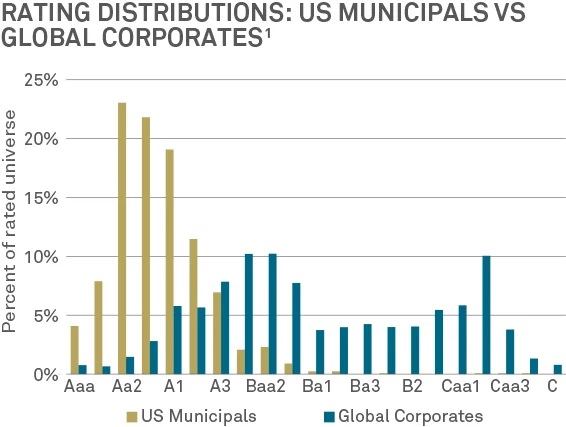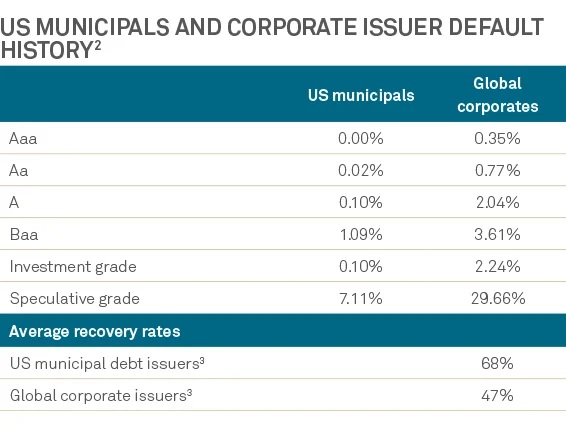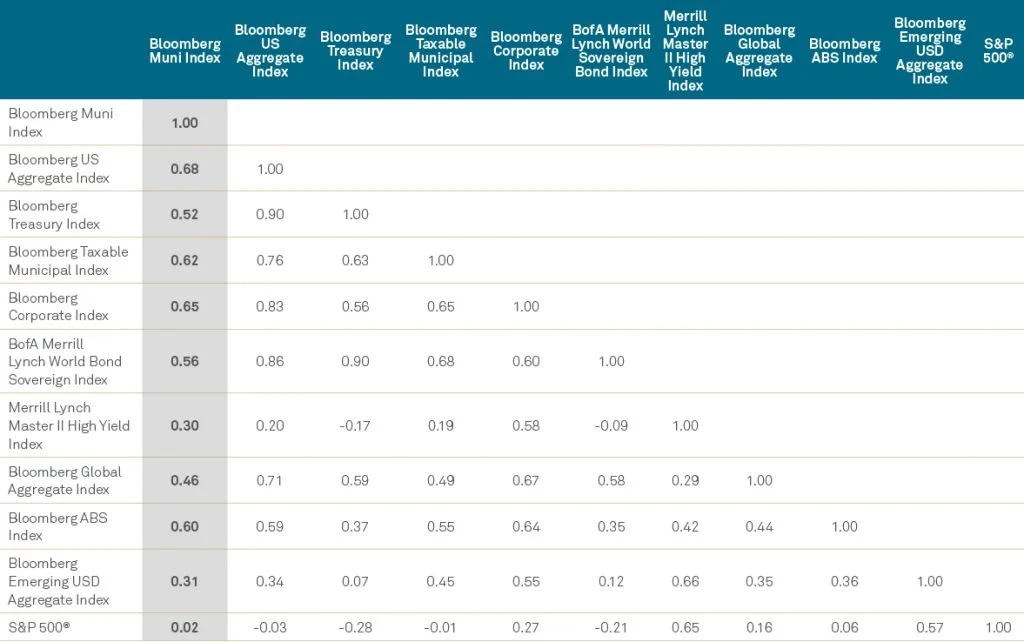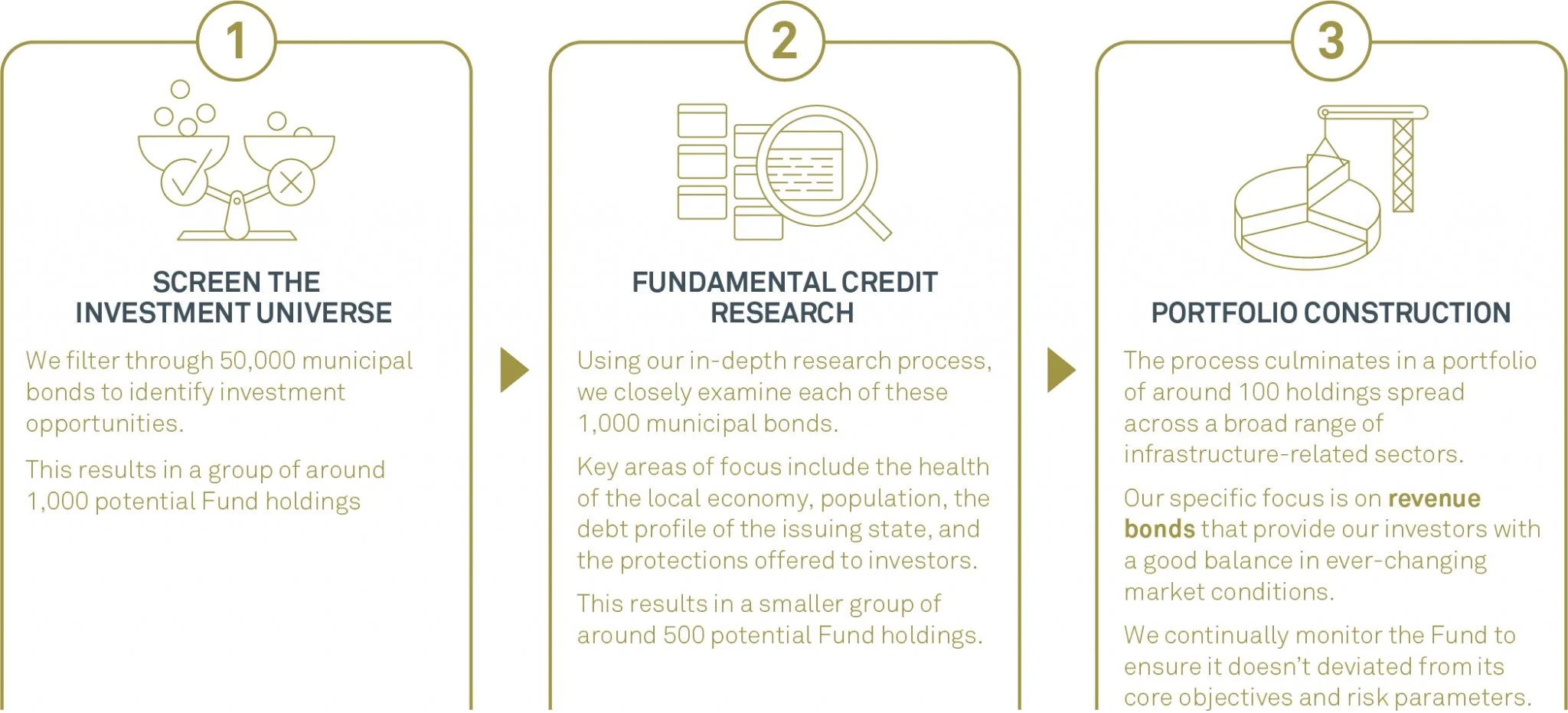DISCOVER
BNY MELLON
- The Fund invests primarily in municipal bonds, which are issued by a state, municipality, not-for-profit corporate issuers of United States to finance infrastructure sectors and projects conducted in the United States of America.
- The Fund’s investment portfolio may fall in value and there is no guarantee of the repayment of principal.
- Adverse economic, political or regulatory changes or adverse factors could result in adverse changes which can significantly affect the revenue generated and the overall market. This may lead to defaults on payment of principal or interest of the municipal bonds. The federal government of the United States are not obliged to support any municipal bonds in default. The Fund could suffer substantial loss.
- Municipal bond markets may not be liquid and quoted prices for the same bond may materially differ. The market is generally subject to a lesser degree of transparency which may possibly lead to higher trading costs for the Fund. Municipal bonds may also be subject to call and/or prepayment risk.
- There are specific risks associated with certain municipal sectors that the Fund may invest, including general obligation bonds risk, revenue bonds risk, private activity bonds risk, moral obligation bonds risk, municipal notes risk and municipal lease obligations risk.
- The Fund is exposed to risks associated with debt securities, including credit risk, interest rate and inflation risk, downgrading risk, credit rating risk and sub-investment grade debt securities risk.
- The Fund‘s investments are concentrated in United States and may be more susceptible to adverse economic, political, policy, foreign exchange, liquidity, tax, legal or regulatory event affecting the United States.
- The Fund may pay dividend effectively out of capital which amounts to a return or withdrawal of part of an investor’s original investment or from any capital gains attributable to that original investment. Any such distributions may result in an immediate reduction of Net Asset Value per share.
- The Fund may use derivatives for efficient portfolio management (EPM) and investment purpose which may be volatile, involve special risks such as risk of disproportionate loss due to leverage, counterparty/ credit risk, liquidity risk, valuation risk over-the-counter risk which could lead to a high risk of significant loss.
- Investors should not rely solely on this document to make investment decision. Please read the offering documents carefully for further details including risk factors.

What is U.S. Municipal Infrastructure Debt?
U.S. municipal bonds – a key source of funding for essential public projects
U.S. municipal bonds, also known as muni bonds or munis, are bonds issued by U.S. states, cities or local government bodies. They can take the form of general obligation (GO) bonds, funded via tax revenues, or revenue bonds, secured by an income stream from a specific local infrastructure asset. Historically, this has meant that default rates have been low, and risk adverse investors could consider investing in munis as a way to diversify corporate bond holdings.
The majority of municipal bonds are issued in a format that exempts the holder from U.S. federal income tax, and potentially local state taxes – a significant benefit for many U.S. domiciled citizens and corporates. However, there is a growing section of the municipal bond market that is issued in a fully taxable format – by issuing fully taxable debt, the issuer has greater flexibility on how they can use the proceeds. Taxable municipal bonds generally trade with a higher gross yield than their tax-exempt counterparts, and this has led to an increase in demand from non-U.S. investors.
Today, the U.S. municipal bond market supplies around 80% of the capital needed for U.S. infrastructure maintenance and development1. Currently, there are 56,248 issuers in the market; this represents almost USD4 trillion in lending2.
From an investment perspective, U.S. municipal bonds are seen as a high-quality asset class. Individual U.S. states that issue infrastructure-related bonds might be major economies in their own right, with levels of growth comparable to that of sovereign countries. For example, the gross domestic product of California alone is equivalent to that of the United Kingdom3.
1 Source: SIFMA as at 30 June 2021.
2 Source: SIFMA as at 30 June 2021.
3 Source: Bureau of Economic Analysis (BEA) and International Monetary Fund as at 31 December 2020.
U.S. Municipal bonds can offer

What does U.S. infrastructure debt typically finance?

Why consider this asset class?
The left-hand graph below shows the ratings of all U.S. municipal bonds versus global corporate bonds, with ‘Aaa’ being the highest and C the lowest. As you can see, most U.S. municipal bonds fall within the higher-quality end of the ratings scale.
Meanwhile, the right-hand table demonstrates the relatively lower defaults among U.S. municipal bonds in relation to global corporate bonds. It also reveals that recovery rates for municipal bonds are higher than those of senior unsecured global corporate bonds. This means investors may have a better chance of getting some of their money back if a U.S. municipal bond defaults.


Sources: 1. Moody’s Investors Services as at 31 December 2020; 2. Source: Moody’s cumulative default rates by rating category, 1970-2020; 3. Moody’s Investors Service as at 30 September 2020, average corporate debt recovery rates for senior unsecured bonds 1970-202.
In this table, we show how the performance of the U.S. municipal bond market compares to other types of fixed-income instruments. From January 1997 to September 2021, for every 1% of growth in the U.S.municipal bond market, you would have achieved only 0.68% had the same amount been invested in investment-grade bonds or 0.52% from U.S. Treasuries.

Source: Bloomberg, Barclays, Merrill Lynch as at 30 September 2021. *Correlation matrix based on total returns, since 1 January 1997
We often hear the term “monetary tightening”. What this refers to is the process of raising interest rates. Central banks often do this to cool an overheating economy, as higher interest rates make borrowing more expensive. Higher interest rates can also make the interest paid out by some bonds look less appealing, as investors could potentially find higher rates elsewhere.
In the graph below, we show that despite increases in U.S. interest rates, based on historical data, municipal bond performance (including reinvestment of income) were able to deliver positive returns. Investors may consider U.S. municipal bonds in an adverse performance environment for fixed income.

Source: Municipal Market Data MMD, FRED, Bloomberg, firm data as at 30 June 2021. For illustrative purposes only.
Note: the bars labelled “1-5 yr”, “1-10 yr” and “3-15 yr” are representative of the returns of the “1-5 year”, “1-10 year” and “3-15 year” Bloomberg Barclays U.S. Municipal Index respectively. The bars labelled “Muni” are representative of the Bloomberg Barclays U.S. Municipal Index’s total returns in the corresponding years on the X-axis (i.e. 1994/1995, 1999/2000, 2004-2006 and Dec 2015 – Dec 2018). The time periods depicted in the chart are the most recent instances where the Federal Reserve tightened monetary policy, or raised interest rates (as shown by the green bar representing the magnitude of rate hikes). Similarly, the blue bars show the relative performance of several distinct municipal indices during the same time period (delivering positive returns).
Why the BNY Mellon U.S. Municipal Infrastructure Debt Fund?
Launched in 2017, the BNY Mellon U.S. Municipal Infrastructure Debt Fund was one of the first products to invest predominately in taxable and tax-exempt infrastructure-focused U.S. municipal bonds.
The Fund aims to provide as high a level of income as is consistent with the preservation of capital. This is not a capital guaranteed fund and there is no guarantee of the repayment of principal.
By taking a long-term approach to investing, our dedicated U.S. municipal debt team seeks to capture opportunities in the U.S. municipal bond market. The team invests in taxable and tax-exempt municipal infrastructure bonds, enabling it to uncover the holdings which are most likely to help us to achieve the fund’s investment objective.
We take a pragmatic, long-term approach to investing. This allows our team to identify bonds that are attractive on a risk-adjusted basis.

The USD4 trillion municipal bond market is a natural avenue for ESG investing. State and local governments regularly finance numerous long-term public projects that align well with sustainable missions led by prudent and responsible governance.
Our team of senior sector and region-specific research analysts formulate recommendations based on myriad
fundamental credit factors including traditional metrics such as balance sheet, economic/tax base, financial metrics and bond covenants. Beyond traditional metrics, our analysts consider key ESG risk and opportunity themes across a wide subset of sectors. Our proprietary Muni ESG analytical framework breaks down ESG risks into five key themes: climate change, aging US infrastructure, natural resource scarcity, demographic shifts and governance.
These risks have credit and fiscal implications for a municipality’s spending, debt, revenues, liquidity, and rainy-day
reserve profiles. Careful consideration of these factors, along with traditional fundamental credit metrics, trading
levels and ratings analysis, are key to our bond selection process.
About the Fund
Minimum initial investment
EUR5,000
ISIN
IE00BDCJYF87
Bloomberg code
BNUMEHA
Benchmark
50% Bloomberg Barclays U.S. Municipal Bond Total Return Index, 50% Bloomberg Barclays Taxable U.S. Municipal Bond Total Return Index
Launch date
29 May 2020
Minimum initial investment
EUR5,000
ISIN
IE00BDCJYG94
Bloomberg code
BNUMEHI
Benchmark
50% Bloomberg Barclays U.S. Municipal Bond Total Return Index, 50% Bloomberg Barclays Taxable U.S. Municipal Bond Total Return Index
Launch date
29 May 2020
Minimum initial investment
USD15,000,000
ISIN
IE00BDCJZ442
Bloomberg code
BNUMUWA
Benchmark
50% Bloomberg Barclays U.S. Municipal Bond Total Return Index, 50% Bloomberg Barclays Taxable U.S. Municipal Bond Total Return Index
Launch date
29 May 2020
Minimum initial investment
USD15,000,000
ISIN
IE00BDCJZ558
Bloomberg code
BNUMUWI
Benchmark
50% Bloomberg Barclays U.S. Municipal Bond Total Return Index, 50% Bloomberg Barclays Taxable U.S. Municipal Bond Total Return Index
Launch date
29 May 2020
Minimum initial investment
USD5,000
ISIN
IE00BDCJY817
Bloomberg code
BNMIDAI
Benchmark
50% Bloomberg Barclays U.S. Municipal Bond Total Return Index, 50% Bloomberg Barclays Taxable U.S. Municipal Bond Total Return Index
Launch date
29 October 2021
Minimum initial investment
USD5,000
ISIN
IE00BDCJY700
Bloomberg code
BMUIDAU
Benchmark
50% Bloomberg Barclays U.S. Municipal Bond Total Return Index, 50% Bloomberg Barclays Taxable U.S. Municipal Bond Total Return Index
Launch date
29 May 2020
Minimum initial investment
USD5,000
ISIN
IE00BMQBXD40
Bloomberg code
BMUSMAI
Benchmark
50% Bloomberg Barclays U.S. Municipal Bond Total Return Index, 50% Bloomberg Barclays Taxable U.S. Municipal Bond Total Return Index
Launch date
28 January 2021
Minimum initial investment
USD5,000
ISIN
IE0008ZKGY86
Bloomberg code
BNUMSUM ID
Benchmark
50% Bloomberg U.S. Municipal Bond Total Return Index
Launch date
19 April 2017
Minimum initial investment
USD5,000
ISIN
IE0007ODN6Q9
Bloomberg code
BNYMIDA ID
Benchmark
Bloomberg Municipal Bond/Taxable U.S. Municipal Bond (30: 70)
Launch date
19 April 2017
*Please note that each SFC-authorized sub-fund of BNY Mellon Global Funds, plc is not aiming to incorporate ESG factors as its key investment focus and, as such, does not constitute an ESG fund pursuant to the Circular to management companies of SFC- authorized unit trusts and mutual funds - ESG funds issued by the SFC on 29 June 2021. Other funds which are not authorized for offering to retail investors may or may not constitute ESG funds (where defined in the relevant local jurisdiction).
This material is for retail investors and is not intended as investment advice. Investment involves risk. Past performance is not a guide to future performance. The offering document of the fund(s) and the Key Facts Statements (KFS) should be read for further details including the risk factors, in particular (where relevant) those associated with investments in emerging markets or using financial derivative instruments for investment purposes. Past performance information presented is not indicative of future performance. Investment returns may be exposed to exchange rate fluctuations. The value of investments may go down or up. This document has not been reviewed by the Securities and Futures Commission. You should not rely on this document alone to make investment decisions. If you are in any doubt about any of the contents of this document, you should obtain independent professional advice. This document may not be used for the purpose of an offer or solicitation in any jurisdiction or in any circumstances in which such offer or solicitation is unlawful or not authorised. This material should not be published or distributed without due authorization from issuer. No warranty is given as to the completeness of this information and no liability is accepted for omissions in such information. The Fund is a sub-fund of BNY Mellon Global Funds, plc (BNY MGF), an open-ended investment company with variable capital (ICVC) with segregated liability between sub-funds. Incorporated with limited liability under the laws of Ireland and authorised by the Central Bank of Ireland as a UCITS fund. The Fund may not be registered for sale in some markets.
In Hong Kong, the issuer of this document is BNY Mellon Investment Management Hong Kong Limited, which is registered with the Securities and Futures Commission (Central Entity Number: AQI762). This document has not been reviewed by the Securities and Futures Commission. Information in this document is subject to change without notice. To the extent permitted by applicable laws, rules, codes and guidelines, BNY Mellon Investment Management Hong Kong Limited accepts no liability whatsoever whether direct or indirect that may arise from the use of or reliance on the information contained in this document. The information has been provided without taking into account the investment objective, financial situation or needs of any particular person. To the extent permitted by applicable laws, rules, codes and guidelines, BNY Mellon Investment Management Hong Kong Limited and its affiliates are not responsible for any subsequent investment advice given based on the information supplied. BNY Mellon Investment Management Hong Kong Limited and any other BNY Mellon entity mentioned are ultimately owned by The Bank of New York Mellon Corporation.
MC605-30-07-2025 (12M)